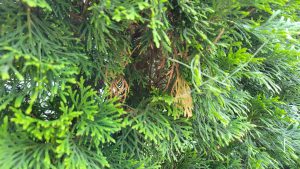
It seems that every May we get a lot of calls coming into our office regarding sick evergreens, with tree owners worrying that their Magnolias or Arborvitae must be dying. This usually comes from the presence of lots of droopy, yellowing foliage that seem to fall off at a startling rate, leading to the conclusion that the tree must be dying and needs immediate attention to keep it healthy. While I applaud these individuals for paying such close attention, l can say with relative confidence that it is nothing to worry about. The plants are simply going through their annual color change and leaf drop, but the timing catches everyone off-guard – so let’s explore why this occurs.

First, and foremost, evergreen trees do not hold their foliage forever. While this sounds like a very simple statement, and obvious to boot, we never really get to see these plants drop their foliage and have bare limbs, unless, of course they have died. This is because evergreen plants have foliage that live for 2 to 3 years and then fall off. As an evergreen tree grows, new stems extension occurs, and new leaves develop outside of the older foliage, encasing the old leaves deeper inside of the canopy.
During the spring flush of new growth, the now 2 to 3 year old leaves are deep inside of the canopy, are no longer photosynthesizing much because of shading, and likely have a significant amount of damage from years of weathering. This means that the old foliage is now of little use to the tree, but is still rich in nutrients that can be used elsewhere within the tree. This is where evergreen trees get really cool because they end up being more efficient than deciduous trees.
When deciduous trees come to the end of the growing season, they flush their foliage with enzymes to break down chlorophyll and other pigments so that the nutrients contained in these compounds can be used later, rather than being wasted. This requires the deciduous trees to transport all of the nutrients deeper into the tree where they will be held over the dormant season to be translocated again in the spring to aid in the formation of new foliage. While this is a wonderful adaptation that limits the wasting of nutrients, it is much more cumbersome than what evergreens do. During the spring flush of new growth, evergreens are able to break down compounds in the old leaves and immediately use those nutrients to help with the development of the newly-expanding foliage. This makes the process simpler and more direct for the plant.
Once the foliage has been stripped of useful nutrients, the leaves will yellow, droop, and begin to fall off, which is where most of the concern begins. It can look quite scare, especially on Southern Magnolias – which get very droopy during this period, and the canopy becomes thinner in appearance because of the loss of old, large leaves and the slow development of new leaves. Nearly all evergreens in the Central Virginia area go through this type of Spring leaf drop. Some of the most visually striking foliage drop occurs in American Hollies, Southern Magnolia, Ligustrum, ‘Green Giant’ Arborvitaes, and Leyland Cypress.

The color change on Leyland Cypress can also be the most concerning to tree owners, as many are aware of the Seiridium Canker disease that is slowly killing Leyland Cypress. This yellowing can start sounding alarm bells for some.
One final thing to remember with evergreen trees is that if foliage is damaged during a growing season from disease or mechanical damage (from something like a hail storm), that year’s growth my fall prematurely. This can lead to a very bare looking tree, as there are always at least two years worth of growth on an evergreen tree at all times, except when this happens. This premature foliage drop may leave a tree or shrub looking quite bare and straggly for at least one full growing season before it can reestablish 2 years of foliage again.
Next time you see an evergreen with a yellow interior in the Spring, congratulate yourself for paying close enough attention in the first place. Then remember what you are actually seeing, and time a moment to appreciate the unique process that is occurring and how it’s nearly the same, but starkly different, as the normal leaf fall we come to celebrate (or hate) every fall on deciduous trees.


